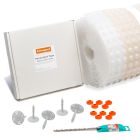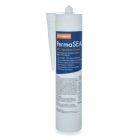Help & Advice Articles, Videos and How-to-Guides
Filter Articles

Damp Proofing Treatment and Costs
Damp problems in buildings are usually caused by condensation or penetrating damp. In some rarer cases, rising damp is the root cause. Any damp issue can pose a real problem to homeowners. They can ruin your interior decoration, damage carpets and woodwork, and in severe cases, cause structural damage. Damp can also make your home feel unwelcoming.
Many people avoid treating damp early on because they believe the treatment is expensive. This isn't often the case. It’s also worth noting that delaying treatment will exacerbate the problem, making it more expensive. If your property is suffering from damp, the best thing to do is act fast - it will save you a lot of hassle and money.
DISCLAIMER: costs quoted in the article are correct at the time of writing. Prices are subject to change over time.
How Much Does Damp Proofing Cost?
The cost of damp proofing depends on several factors, such as the area affected, the extent of the problem and the recommended solution. You also must consider any costs associated with who carries out the work. The cost of the damp proofing solution can be relatively low, but resolving the root cause can be expensive. For example, if you have a severe crack in the wall, you will need to pay for helical bars to fix the issue before you can purchase the damp proofing required.
At Permagard, we work hard to pass on savings to our customers and keep costs to a minimum whilst maintaining the highest quality. Our overview lists the prices of our own treatments (excluding delivery). For more details about each treatment and the factors that make up these costs, click on the jump links below.
Jump Links
Breaking Down Damp Proofing Costs
There are three main types of damp that all have unique solutions and a wide range of costs: condensation, penetrating damp and rising damp. You’ll also need to factor in the cost of fixing the cause, such as leaky pipes or a wall crack, and the professional diagnosis needed before proceeding with treatment. Our guide to damp surveys breaks down some of these costs.
Condensation Treatment Costs
Condensation is relatively inexpensive to treat, providing you spot it early. There are a range of condensation control products on the market, from preventative methods to treating the effects of condensation. These span from anti-condensation paint to whole-house ventilation systems.
Minor condensation problems can be treated cheaply and quickly. Permagard stock a passive condensation control vent with no moving parts that is easy to install for £23.94 inc VAT. However, more severe cases of condensation may need a conversation with our technical experts to direct you on what solutions are suitable for your property.
We’ve listed some of the condensation treatments we offer at Permagard as a quick overview:
| Condensation Treatment Type | Cost |
|---|---|
| Perma-Vent Condensation Control Vent | £23.94 (inc VAT) |
| Kair Heat Recovery Room Ventilator K-HRV150/12RH | £323.94 (inc VAT) |
| Nuaire Drimaster Eco LC with Loft Control | £348.00 (inc VAT) |
Depending on the scale of the issue, you might also want to factor in mould removal costs. Our PermaPROTECT Mould Removal Kit includes all you need to easily clean mould and keep it from coming back. It costs £25.80, or you can buy our PermaPROTECT Mould Wash Concentrate for £8.10.
Read more:
- Positive Ventilation Systems: The Pros and Cons
- How to Get Rid of Condensation
- How to Avoid Condensation in Your Bathroom and Prevent Mould
- How to Stop Window Condensation
- How to Ventilate Your House
Penetrating Damp Treatment Costs
Before treating penetrating damp, you will first need to resolve the underlying building fault - the cost of this will depend on the issue and the extent of the damage. Roofs tend to be significantly more expensive to fix than leaking pipes.
In terms of penetrating damp treatment costs, the most affordable and common remedy is to apply a facade cream water repellent to the outside of the property. You can do this yourself with a high quality cream-based water repellent:
| Penetrating Damp Treatment | Cost |
|---|---|
| PermaSEAL Facade Cream | £69.00 (inc VAT) |
| PermaSEAL Brick Sealer | £21.12 (inc VAT) |
In some scenarios, it may be necessary to apply a damp proof membrane to isolate the damp wall and protect final finishes and decoration while it dries out. Or a tanking slurry applied to the inside walls to prevent water ingress.
Read more:
Rising Damp Costs
Rising damp is probably the most expensive form of damp to cure. It’s also the rarest. Considering its severity, it is a job that needs to be done properly. The first step is a professional diagnosis to rule out other forms of damp.
Treatment usually requires the installation of a new chemical damp proof course (DPC). Injection DPCs act as an impermeable barrier and protect against groundwater rising up your walls. You will also need to apply a damp proof membrane and replaster to a precise specification to treat salts and prevent the damp from reappearing.
At Permagard, you can either purchase our PermaSEAL PRO DPC Injection Cream as individual cartridges or as part of a kit. We’ve included both in our breakdown below:
| Rising Damp Treatment | Cost |
|---|---|
| PermaSEAL PRO DPC Injection Cream | £14.40 (inc VAT) |
| Caulking Gun 300ml | £10.44 (inc VAT) |
| Extension Tube 10mm x 350mm | £0.80 (inc VAT) |
| Armeg SDS Plus Hammer Drill Bit 12mm x 300mm | £10.74 (inc VAT) |
| PermaSEAL PRO DPC Injection Kit 310ml x 10 | £126.00 (inc VAT) |
Read more:
Permagard - Low Trade Prices
If you have any questions about the costs associated with damp proofing a property, we’re here to help. You can call our friendly technical team on 0117 982 3282 or email us at [email protected] for free advice on your project — we’re always happy to help.
Show updates
- 21/11/2025 — Updated prices and inserted tables to aid clarity. Rewrote sections to make clearer the costs of damp treatment.



